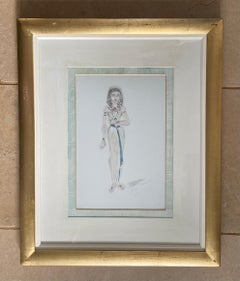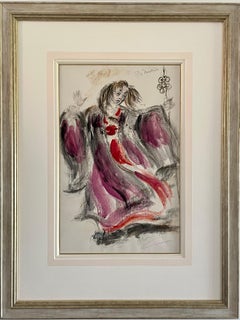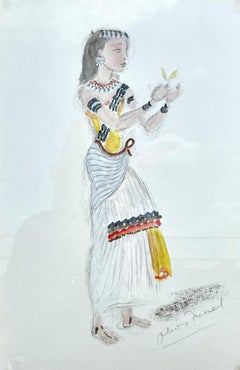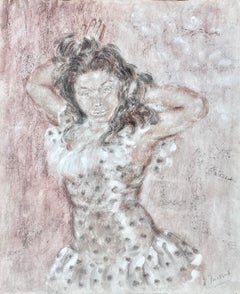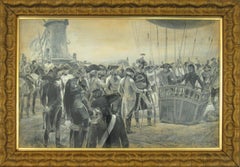Oliver Messel Figurative Drawings and Watercolors
British, 1904-1978
Born in London, his mother being the daughter of the Punch cartoonist Edward Linley Sambourne and his father a soldier and stockbroker. After Eton he studied art at the Slade under Henry Tonks; Rex Whistler was a fellow student. Although his studies concentrated on life drawings he also made papier mache and wax masks for student events and an exhibition of these masks at the Claridge Galleries in 1925 let to his first theatre design commission for the Diaghilev ballet production of Zeephyre et Flore. By the early 1930s had established himself as one of Britain’s principal designers for the stage. He went on to design for many theatrical, operatic, ballet and film productions becoming one of the most highly paid and sought after theatre designers in the world.
His books included Stage Designs and Costumes, 1933; Designs for A Midsummer Night’s Dream, 1957 and Delightful Food, 1958. He held one-man exhibitions at the Leicester Galleries and Redfern Gallery, designed interiors and gardens of the Dorchester Hotel, Flaxley Abbey, Gloucestershire and elsewhere as well as several houses and grounds in Barbados and Mustique. The Victoria & Albert Museum hold the majority of his design archives.(Biography provided by Sarah Colegrave Fine Art)
to
6
4
6
5
1
Overall Height
to
Overall Width
to
6
6
4
2
2
2
1
1
1
6
1
7
723
326
196
132
6
6
1
Artist: Oliver Messel
Oliver Messel - Costume Design for Vivian Leigh in Caesar and Cleopatra - 1945
By Oliver Messel
Located in London, GB
OLIVER MESSEL
(1904-1978)
Blue Costume Design for Vivian Leigh in Caesar and Cleopatra - 1945
Signed l.r.: Oliver Messel
Watercolour and chalks heightened with white and gold pain...
Category
Mid-20th Century Realist Oliver Messel Figurative Drawings and Watercolors
Materials
Watercolor
Rashomon - A 1950 costume design for the New York Theatre by Oliver Messel
By Oliver Messel
Located in London, GB
OLIVER MESSEL
(1904-1978)
The Medium – Costume Design for Peter Glenville’s Rashomon, Performed at the Music Box, New York, 1959
Signed l.r.: Oliver Messel and inscribed u.r.: The...
Category
Mid-20th Century Realist Oliver Messel Figurative Drawings and Watercolors
Materials
Watercolor
Oliver Messel - Costume Design for Caesar and Cleopatra, 1945
By Oliver Messel
Located in London, GB
OLIVER MESSEL
(1904-1978)
Egyptian Costume Design for Caesar and Cleopatra - 1945
Signed l.r.: Oliver Messel
Watercolour and chalks heightened ...
Category
Mid-20th Century Realist Oliver Messel Figurative Drawings and Watercolors
Materials
Watercolor
Oliver Messel - Costume Design for Vivien Leigh in Caesar and Cleopatra
By Oliver Messel
Located in London, GB
OLIVER MESSEL
(1904-1978)
Blue Costume Design for Caesar and Cleopatra - 1945
Signed l.r.: Oliver Messel
Watercolour and chalks heightened with...
Category
Mid-20th Century Oliver Messel Figurative Drawings and Watercolors
Materials
Watercolor
The Dancer - 20th Century British painting by Oliver Messel
By Oliver Messel
Located in London, GB
OLIVER MESSEL
(1904-1978)
Dancer
Signed l.r.: Oliver Messel
Oil and watercolour on paper
Framed
60 by 50 in., 23 ½ by 19 ¾ cm.
(Frame size 76.5 by 66.5 in., 30 by 26 ¼ cm.)
Bor...
Category
Mid-20th Century Realist Oliver Messel Figurative Drawings and Watercolors
Materials
Watercolor, Oil
Opera Costume Design for The Barber of Seville by Oliver Messel
By Oliver Messel
Located in London, GB
OLIVER MESSEL
(1904-1978)
Costume Design for Rosina in the Barber of Seville
Signed and indistinctly inscribed
Watercolour and bodycolour, framed
...
Category
1950s Realist Oliver Messel Figurative Drawings and Watercolors
Materials
Watercolor
Related Items
The Abduction of the Sabine Women , a Renaissance drawing by Biagio Pupini
Located in PARIS, FR
This vigorous drawing has long been attributed to Polidoro da Caravaggio: The Abduction of the Sabine Women is one of the scenes that Polidoro depicted between 1525 and 1527 on the façade of the Milesi Palazzo in Rome. However, the proximity to another drawing inspired by this same façade, kept at the Ecole des Beaux-Arts, and to other drawings inspired by Polidoro kept at the Musée du Louvre, leads us to propose an attribution to Biagio Pupini, a Bolognese artist whose life remains barely known, despite the abundant number of drawings attributed to him.
1. Biagio Pupini, a Bolognese artist in the light of the Roman Renaissance
The early life of Biagio Pupini, an important figure of the first half of the Cinquecento in Bologna - Vasari mentions him several times - is still poorly known. Neither his date of birth (probably around 1490-1495) nor his training are known. He is said to have been a pupil of Francesco Francia (1450 - 1517) and his name appears for the first time in 1511 in a contract with the painter Bagnacavallo (c. 1484 - 1542) for the frescoes of a church in Faenza. He then collaborated with Girolamo da Carpi, at San Michele in Bosco and at the villa of Belriguardo.
He must have gone to Rome for the first time with Bagnacavallo between 1511 and 1519. There he discovered the art of Raphael, with whom he might have worked, and that of Polidoro da Caravaggio. This first visit, and those that followed, were the occasion for an intense study of ancient and modern art, as illustrated by his abundant graphic production.
Polidoro da Caravaggio had a particular influence on the technique adopted by Pupini. Executed on coloured paper, his drawings generally combine pen, brown ink and wash with abundant highlights of white gouache, as in the drawing presented here.
2. The Abduction of the Sabine Women
Our drawing is an adaptation of a fresco painted between 1525 and 1527 by Polidoro da Caravaggio on the façade of the Milesi Palace in Rome. These painted façades were very famous from the moment they were painted and inspired many artists during their stay in Rome. These frescoes are now very deteriorated and difficult to see, as the palace is in a rather narrow street.
The episode of the abduction of the Sabine women (which appears in the centre of the photo above) is a historical theme that goes back to the origins of Rome and is recounted both by Titus Livius (Ab Urbe condita I,13), by Ovid (Fasti III, 199-228) and by Plutarch (II, Romulus 14-19). After killing his twin brother Romus, Romulus populates the city of Rome by opening it up to refugees and brigands and finds himself with an excess of men. Because of their reputation, none of the inhabitants of the neighbouring cities want to give them their daughters in marriage. The Romans then decide to invite their Sabine neighbours to a great feast during which they slaughter the Sabines and kidnap their daughters.
The engraving made by Giovanni Battista Gallestruzzi (1618 - 1677) around 1656-1658 gives us a good understanding of the Polidoro fresco, allowing us to see how Biagio Pupini reworked the scene to extract this dynamic group.
With a remarkable economy of means, Biagio Pupini takes over the left-hand side of the fresco and depicts in a very dense space two main groups, each consisting of a Roman and a Sabine, completed by a group of three soldiers in the background (which seems to differ quite significantly from Polidoro's composition).
The balance of the drawing is based on a very strongly structured composition. The drawing is organised around a median vertical axis, which runs along both the elbow of the kidnapped Sabine on the left and the foot of her captor, and the two main diagonals, reinforced by four secondary diagonals. This diamond-shaped structure creates an extremely dynamic space, in which centripetal movements (the legs of the Sabine on the right, the arm of the soldier on the back at the top right) and centrifugal movements (the arm of the kidnapper on the left and the legs of the Sabine he is carrying away, the arm of the Sabine on the right) oppose each other, giving the drawing the appearance of a whirlpool around a central point of support situated slightly to the left of the navel of the kidnapper on the right.
3. Polidoro da Caravaggio, and the decorations of Roman palaces
Polidoro da Caravaggio was a paradoxical artist who entered Raphael's (1483 - 1520) workshop at a very young age, when he oversaw the Lodges in the Vatican. Most of his Roman work, which was the peak of his career, has disappeared, as he specialised in facade painting, and yet these paintings, which are eminently visible in urban spaces, have influenced generations of artists who copied them abundantly during their visits to Rome.
Polidoro Caldara was born in Caravaggio around 1495-1500 (the birthplace of Michelangelo Merisi, known as Caravaggio, who was born there in 1571), some forty kilometres east of Milan. According to Vasari, he arrived as a mason on the Vatican's construction site and joined Raphael's workshop around 1517 (at the age of eighteen according to Vasari). This integration would have allowed Polidoro to work not only on the frescoes of the Lodges, but also on some of the frescoes of the Chambers, as well as on the flat of Cardinal Bibiena in the Vatican.
After Raphael's death in 1520, Polidoro worked first with Perin del Vaga before joining forces with Maturino of Florence (1490 - 1528), whom he had also known in Raphael's workshop. Together they specialised in the painting of palace façades. They were to produce some forty façades decorated with grisaille paintings imitating antique bas-reliefs.
The Sack of Rome in 1527, during which his friend Maturino was killed, led Polidoro to flee first to Naples (where he had already stayed in 1523), then to Messina. It was while he was preparing his return to the peninsula that he was murdered by one of his assistants, Tonno Calabrese, in 1543.
In his Vite, Vasari celebrated Polidoro as the greatest façade decorator of his time, noting that "there is no flat, palace, garden or villa in Rome that does not contain a work by Polidoro". Polidoro's facade decorations, most of which have disappeared as they were displayed in the open air, constitute the most important lost chapter of Roman art of the Cinquecento. The few surviving drawings of the painter can, however, give an idea of the original appearance of his murals and show that he was an artist of remarkable and highly original genius.
4. The façade of the Milesi Palace
Giovanni Antonio Milesi, who commissioned this palace, located not far from the Tiber, north of Piazza Navona, was a native of the Bergamo area, like Polidoro, with whom he maintained close friendly ties. Executed in the last years before the Sack of Rome, around 1526-1527, the decoration of Palazzo Milesi is considered Polidoro's greatest decorative success.
An engraving by Ernesto Maccari made at the end of the nineteenth century allows us to understand the general balance of this façade, which was still well preserved at the time. The frescoes were not entirely monochrome, but alternated elements in chiaroscuro simulating marble bas-reliefs and those in ochre simulating bronze and gold vases...
Category
16th Century Old Masters Oliver Messel Figurative Drawings and Watercolors
Materials
Ink, Gouache, Pen
Richard Caton Woodville II (1856 - 1927) 1794 War Balloon Aquarell England 1910
By Richard Caton Woodville Jr.
Located in Meinisberg, CH
Richard Caton Woodville II
(British, 1856 - 1927)
The French Aerostatic Corps - The first War Balloon The launching of the L'Entreprenant used by the French Army under General Jourd...
Category
1910s English School Oliver Messel Figurative Drawings and Watercolors
Materials
Paper, Watercolor, Gouache, Cardboard
Free Shipping
H 15.56 in W 22.25 in D 1.58 in
The Star Press - Drawing by Suzanne Tourte - 1950s
Located in Roma, IT
The star press is an artwork realized by Suzanne Tourte, in 1950s.
Original watercolor.
33 x 25 cm.
Good conditions, except for some yellowing on pa...
Category
1950s Modern Oliver Messel Figurative Drawings and Watercolors
Materials
Paper, Watercolor
Wroclaw - Contemporary Watercolor & Ink Landscape Painting, Architecture
By Mariusz Szałajdewicz
Located in Warsaw, PL
Mariusz Szalajdewicz (b. 1974)
Studied at the Faculty of Architecture at Warsaw University of Technology, where he mastered the drawing skill. Architect and urbanist, illustrator.
...
Category
21st Century and Contemporary Realist Oliver Messel Figurative Drawings and Watercolors
Materials
Ink, Watercolor, Paper
In Toadstools - Contemporary Figurative Ink, Watercolor Painting, New Expression
Located in Salzburg, AT
The artwork is in plain Ikea frame behind plexi
Unframed size: 36x48 cm, Framed 42.5x52.5 cm
Grażyna Rigall is a painter, illustrator, author of stage designs and music videos. - Th...
Category
2010s Contemporary Oliver Messel Figurative Drawings and Watercolors
Materials
Paper, Ink, Watercolor
Boulevard at summer. 1961, paper, watercolor, 37x52 cm
Located in Riga, LV
Boulevard. 1961, paper, watercolor, 37x52 cm
Laimdonis Grasmanis (1916-1970)
1933 – 1937 – Art school of Applied art in Liepaja
1937 – 1942 – Art Academy of Latvia
Artist took pa...
Category
1960s Realist Oliver Messel Figurative Drawings and Watercolors
Materials
Paper, Watercolor
H 14.57 in W 20.48 in
Porsche. Figurative realistic acrylic on paper painting Polish art, Car
By Michal Wojtysiak
Located in Warsaw, PL
Acrylic on paper contemporary figurative painting by Michal Wojtysiak. Artwork depicts Porsche 993 Turbo car in realistic style. The color is vibrant and saturated. Michal Wojtysiak...
Category
2010s Realist Oliver Messel Figurative Drawings and Watercolors
Materials
Paper, Acrylic
"Study for decoration Moscow metro station" Kievskaya Tempera, Real socialism
Located in Torino, IT
Real Socialism,Moscow,1970,Russia,Orange,Men at Work,Propaganda
VIKTOR A. KONOVALOV (Uidol, Vladimir region 1912 – Moscow 1995)
Russian painter and gr...
Category
1950s Realist Oliver Messel Figurative Drawings and Watercolors
Materials
Paper, Tempera
The Flower Seller - French Realist Figurative Watercolor by Victor Gilbert
By Victor Gabriel Gilbert
Located in Marlow, Buckinghamshire
Signed figurative watercolour on board by French realist painter Victor Gabriel Gilbert. The work depicts a flower seller at her market stall selling beautifully coloured bouquets of...
Category
Early 1900s Realist Oliver Messel Figurative Drawings and Watercolors
Materials
Watercolor, Board
Porsche Panamera. Figurative realistic acrylic on paper painting Polish art, Car
By Michal Wojtysiak
Located in Warsaw, PL
Acrylic on paper contemporary figurative painting by Michal Wojtysiak. Artwork depicts Porsche Panamera car in realistic style.
MICHAŁ WOJTYSIAK (ur. 1984)
Graduated of Academy of Fine Arts in Łódź...
Category
2010s Realist Oliver Messel Figurative Drawings and Watercolors
Materials
Paper, Acrylic
Original Graphic Hungarian Illustration Art Emma Heinzelmann Children's Book Art
Located in Surfside, FL
Original vintage gouache painting on poster board by Emma Heinzelmann (Hungarian, born 1930). Hungarian Peasant art, children fairytale themes, in psychedelic pop colors of the era. This framed painting depicts figures, a rooster and angels in flying above. Artist signature on farm gate. Housed in chrome mid century frame.
Framed: 19.5 X 25.5 image is 15 X 21.
Emma Heinzelmann ( Nyírbátor , March 14 , 1930 - ) Munkácsy Prize-winning Hungarian graphic designer and illustrator.
Heinzelmann is a Hungarian children's book illustrator and graphic poster artist, who started her career during the 1950’s. She has a very unique drawing style that resembles children’s book illustrations. Working in psychedelic pop colors of the era. She Initially she studied to be a costume designer but she soon turned to graphic design. She graduated in 1950 from the clothing design department at the Junior High School in Török Pál Street which operated under the name Szépmíves Lyceum from 1946 to 1950. His master was György Farkas, a ceramicist, painter and sculptor. She creates her compositions using mainly watercolor and gouache paint. She often worked on illustrations for children’s books, since her style fits their themes. Her posters show the same playful Hungarian Folk Art style. She has produced artwork in almost all areas of applied graphics. posters, commemorative cards, designed album covers, postcards, advertising graphics, slide films, animation and cartoons. Her drawings were published in Dörmögő Dömötör and Kisdobos among others as well as in children's magazines. An entire generation of children grew up with her book illustrations, reading the fairy tales of Wilhelm Hauff or Hans Christian Andersen. Her story books and drawings are known well beyond our borders. She illustrated nearly 80 storybooks. She is a contemporary of Maurice Sendak and William Steig. Her work is of the same genre as the iconic Polish Cyrk poster artists.
In her original fine art graphics grotesque and bitter elements often prevail, her figures are playfully ironic. Her drawings are made in a variety of ways, from pencil drawings to watercolor painting to collage techniques, from decorative spot effects to lace-like line drawings. She is no stranger to a kind of Art Nouveau influence, but it is always individual. It was never beautiful, but over the years its color scheme changed, thus confirming the lines of József Somogyi quoted earlier. She had several individual exhibitions, and for more than 10 years as a member of the Papp-Gábor group, her works could be seen in Dorottya Street.
In 2009 , the book of art historian András Székely was published by Holnap Könyvkiadó under the title Emma Heinzelmann: fairy tales in the drawing.
Awards and recognitions
Lot Prize (International Poster Biennale, Warsaw) (1972)
Ministry of Culture Award (1977, 1979)
Brno Graphic Biennale (Bronze Award) (1980)
Worker's Award (1984)
Children's Book of the Year Award (1984)
IBBY Andersen Diploma (1988)
Hamburg Lifetime Achievement Award (1990)
Albert Star Award (1992)
Noémi Ferenczy Award (2005)
Munkácsy Award (1984)
Solo Exhibitions:
Thought Bookstore, Budapest (1965)
Cultural Center, Nyíregyháza (1974)
Little Gallery, Komárom (1982)
Art Gallery, Budapest. (1990)
Vác (2010)
Selected group exhibitions:
International Children's Book Fair and Exhibition, Bologna (1971-1975)
International Graphic Biennale, Brno (1966-1985)
BIB (Children's book illustration biennial), Bratislava (1970-1985)
XXXVI. Venice Biennale, Venice (1972)
ARC. International Poster Biennale, Warsaw (1972)
International Poster Triennale (B) (1972-1974)
Weekdays, graphic exhibition, (1975)
Calligraphy and typography, Institute of Cultural Relations, Budapest (1977)
"Falrahányt pea", graphic exhibition, Institute of Cultural Relations, Budapest.(1978)
International Poster Triennale (B) (1978)
National Poster Exhibitions, Art Gallery, Budapest (1978)(1980)
International Poster Exhibition (IR) (1979)
Slide films:
Fairy tales with Emma Heinzelmann's drawings:
Under the Shore (1981)
Goose Party (1981)
Take a Little Trumpet (1982)
The Bremen Town...
Category
Mid-20th Century Folk Art Oliver Messel Figurative Drawings and Watercolors
Materials
Gouache
1950's Modernist/ Cubist Painting - Blue Watercolor Knight and Horse Statue
By Bernard Labbe
Located in Cirencester, Gloucestershire
French Landscape
by Bernard Labbe (French mid 20th century)
original gouache on paper
size: 13.75 x 10.5 inches
condition: very good and ready to be enjoyed
provenance: the artists ...
Category
Mid-20th Century Modern Oliver Messel Figurative Drawings and Watercolors
Materials
Gouache
Oliver Messel figurative drawings and watercolors for sale on 1stDibs.
Find a wide variety of authentic Oliver Messel figurative drawings and watercolors available for sale on 1stDibs. You can also browse by medium to find art by Oliver Messel in paint, watercolor, oil paint and more. Not every interior allows for large Oliver Messel figurative drawings and watercolors, so small editions measuring 10 inches across are available. Customers who are interested in this artist might also find the work of John Gould, Cecil Beaton, and Raphael Soyer. Oliver Messel figurative drawings and watercolors prices can differ depending upon medium, time period and other attributes. On 1stDibs, the price for these items starts at $1,734 and tops out at $3,185, while the average work can sell for $1,911.
